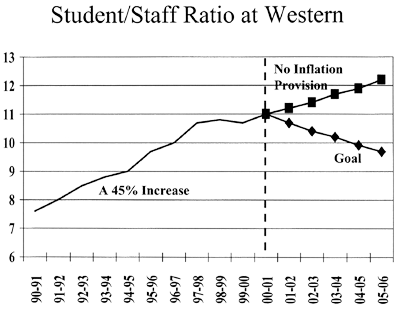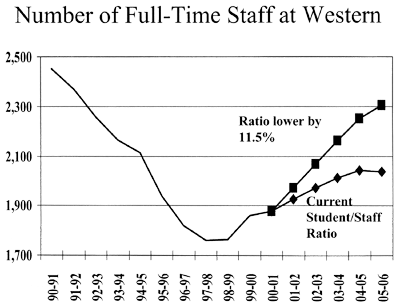Staff
In the midst of unprecedented challenges, Western’s staff continue to demonstrate exceptional commitment to the University’s mission. As the complexity of the work environment increases, the University’s success becomes increasingly dependent upon: 1) operations designed for greatest effectiveness with clear roles, expectations and accountabilities; 2) committed and fully accountable members of the Western community with the skills, knowledge, motivation and abilities to achieve our objectives; and 3) a culture that demands and supports quality, individual and collective achievement, effective partnerships and the best use of time and talent. Western’s staff are central to the University’s ability to create this framework for success.
Staff perform front-line services for students and faculty, in which they take great pride, but the reduction in complement has compromised their ability to perform these services as effectively as they would like. The anticipated growth in student numbers, the significant increase in the types and complexity of research, and the increased volume of activity, coupled with the high ratio of students to staff at Western, make it imperative that the University attract and retain talented staff in a highly competitive market.
Over the past decade, staff in all units have worked hard and effectively to further the University’s academic mission, and administrative and support units have, on average, sustained budget cuts greater than those imposed on academic units. Investment in new staff must be a priority as we look ahead, and investment in learning and training opportunities for current staff is equally important. In our rapidly changing work environment, the nature of the work our staff perform will continue to change and transform, which will require the provision of service in new ways using different methods and approaches. Western must develop mechanisms to identify the skills necessary for staff and managers in a changing workplace environment and to ensure that our employees acquire those skills. We must improve the ability of our managers to facilitate staff development and encourage exceptional performance. Fuller integration of academic and administrative leadership is a means of maintaining a respectful and supportive working environment for all staff.
Related Charts


Significant new investments in staff are required if we are to retain the foundations for a university of international reputation. The cuts of the past decade have increased the student-staff ratio by some 45%. To enhance the quality of education and of student services, we believe that a reduction in the student-staff ratio is vital and that future provincial funding should support that reduction. For the province as a whole, we suggest that the proposed reduction of 11.5% in the student-faculty ratio should also be applied to the student-staff ratio. During the next five years, accommodating enrolment expansion and reducing the student-staff ratio by 11.5% would result in an increase in staff complement of some 425, from 1,879 in 2000-2001 to 2,304 in 2005-2006. At that point, the student-staff ratio would be about 9.7:1, approximately its value in 1995-96, but still well above its value in the 1980s and early 1990s. The additional staff complement would allow the University to provide better services to students, better support for teaching and research, and better ongoing maintenance of University facilities.
Our Commitments:
3. Western will provide an environment supportive of staff productivity, advancement, and aspirations.
Our University community will:
3.1 Maintain a University community where all types of work are respected and value is accorded to all who work to sustain the University’s objectives;
3.2 Explore ways of integrating academic and administrative leadership structures to enable staff to achieve their full potential;
3.3 Hire, train and promote staff strategically to develop skills necessary in the evolving work and learning environment;
3.4 Ensure that our hiring is supportive of applicants from diverse backgrounds, including the designated groups identified under the Employment Equity Act and the Federal Contractors Program;
3.5 Develop an effective and visible means of recognition of exceptional performance by staff;
3.6 Increase opportunities for personal and professional development, by fostering career development among current staff and providing the type of supportive, flexible working environment essential for recruitment at all staff levels;
3.7 Provide opportunities for staff to share ideas laterally among units across the campus;
3.8 Work with staff groups and managers to reduce injuries, work-related illness, and the costs of disability programs;
3.9 Continue to urge alumni, community leaders and provincial officials to support a new investment of public funds in Ontario’s universities which would allow a reduction in the present student-staff ratio of 11.5% by 2006, to improve the quality of education and student services.
